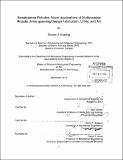| dc.contributor.advisor | Neri Oxman and David Wallace. | en_US |
| dc.contributor.author | Keating, Steven J. (Steven John) | en_US |
| dc.contributor.other | Massachusetts Institute of Technology. Dept. of Mechanical Engineering. | en_US |
| dc.date.accessioned | 2013-03-28T18:12:14Z | |
| dc.date.available | 2013-03-28T18:12:14Z | |
| dc.date.copyright | 2012 | en_US |
| dc.date.issued | 2012 | en_US |
| dc.identifier.uri | http://hdl.handle.net/1721.1/78184 | |
| dc.description | Thesis (S.M.)--Massachusetts Institute of Technology, Dept. of Mechanical Engineering, 2012. | en_US |
| dc.description | Cataloged from PDF version of thesis. | en_US |
| dc.description | Includes bibliographical references (p. 204-208). | en_US |
| dc.description.abstract | This work investigates, defines, and expands on the use of robotic arms in digital fabrication, design, and art through methods including 3D printing, milling, sculpting, functionally graded fabrication, construction-scale additive manufacturing, jammable granular system design, light painting, and volumetric sensing. While most current applications of robotics in manufacturing rely on repetitive automation and assembly tasks, the flexibility, dexterity, and precision of industrial robotic arms provide for design opportunities of multi-functionary roles. Through exploration and demonstration, a multipurpose fabrication platform was developed using a KUKA KR5 sixx R850 robotic arm. The platform is capable of conventional manufacturing techniques spanning the three traditional fabrication categories: additive, subtractive, and formative. Case studies and digital design fabrication protocols were developed as part of the robotic platform to demonstrate these three types of fabrication including 3D printing, multi-axis milling, and clay sculpting, respectively. Compound processes, such as combining 3D printing and milling, were developed that offer product-, and process-based improvements over standalone techniques. The benefits and drawbacks of a multi-fabrication platform are discussed, including cost, physical footprint, resolution, and flexibility. In addition to replicating conventional manufacturing techniques with a single robotic platform, several novel applications were developed which take advantage of the flexibility of an arm system. First, functionally graded 3D printing was explored using concrete through which density gradients were shown to achieve higher structural efficiency. A novel construction-scale additive manufacturing process capable of 3D printing building components was developed. Secondly, direct recycling 3D printing was developed where waste thermoplastic products are transformed into feedstock and printed into new components within a single operation. Work conducted on jammed granular structures, where external pressure controls system stiffness and strength, resulted in several new formative fabrication possibilities. Combined with robotics, waste-free digital casting using jammable materials was enabled along with a variety of design projects including the design of robotic arms themselves. Finally, the use of robotic arms for fabrication of material and environmental properties without mechanical force transfer was explored. Coined immaterial fabrication,t his fabrication category captures methods that do not fall within the definitions of additive, subtractive, or formative processes. Work produced in this area includes a volumetric sensing technique and robotic light paintings that reveal thermal, electromagnetic, and optical fields. | en_US |
| dc.description.statementofresponsibility | by Steven J. Keating. | en_US |
| dc.format.extent | 226 p. | en_US |
| dc.language.iso | eng | en_US |
| dc.publisher | Massachusetts Institute of Technology | en_US |
| dc.rights | M.I.T. theses are protected by
copyright. They may be viewed from this source for any purpose, but
reproduction or distribution in any format is prohibited without written
permission. See provided URL for inquiries about permission. | en_US |
| dc.rights.uri | http://dspace.mit.edu/handle/1721.1/7582 | en_US |
| dc.subject | Mechanical Engineering. | en_US |
| dc.title | Renaissance robotics : novel applications of multipurpose robotic arms spanning design fabrication, utility, and art | en_US |
| dc.title.alternative | Novel applications of multipurpose robotic arms spanning design fabrication, utility, and art | en_US |
| dc.type | Thesis | en_US |
| dc.description.degree | S.M. | en_US |
| dc.contributor.department | Massachusetts Institute of Technology. Department of Mechanical Engineering | |
| dc.identifier.oclc | 829827456 | en_US |
